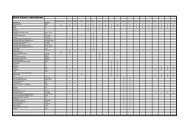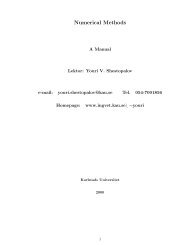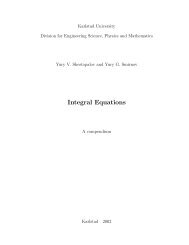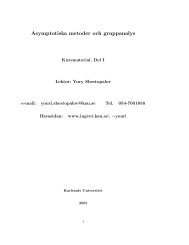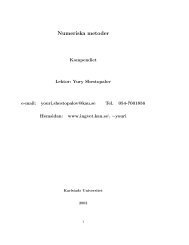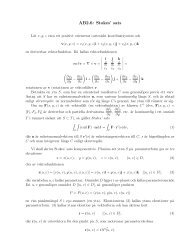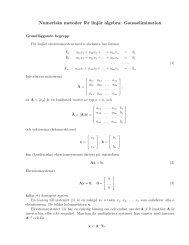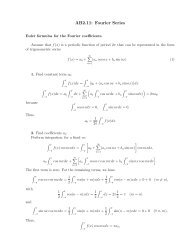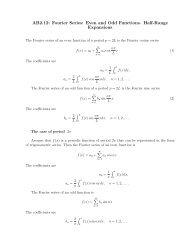Divergence Theorem of Gauss EXAMPLE 1 EXAMPLE 2
AB2.5: Surfaces and Surface Integrals. Divergence Theorem of Gauss
AB2.5: Surfaces and Surface Integrals. Divergence Theorem of Gauss
- No tags were found...
Create successful ePaper yourself
Turn your PDF publications into a flip-book with our unique Google optimized e-Paper software.
AB2.5: Surfaces and Surface Integrals.<strong>Divergence</strong> <strong>Theorem</strong> <strong>of</strong> <strong>Gauss</strong>Representations <strong>of</strong> surfacesorRepresentation <strong>of</strong> a surface S as projections on the xy- and xz-planes, etc. areFor example,z = f(x, y), x = g(x, z)g(x, y, z) = 0.√z = + a 2 − x 2 − y 2 or x 2 + y 2 + z 2 = a 2 , z ≥ 0represents a hemisphere <strong>of</strong> radius a and center O.A surface S can be represented by a vector functionr(u, v) = [x(u, v), y(u, v), z(u, v)] = x(u, v)i + y(u, v)j + z(u, v)k,u, v ∈ RThis is called a parametric representation <strong>of</strong> a surface, u, v varying in a two-dimensionalregion R are the parameters <strong>of</strong> the representation.<strong>EXAMPLE</strong> 1 Parametric representation <strong>of</strong> a cylinderA circular cylinder x 2 + y 2 = a 2 , −1 ≤ z ≤ 1 has radius a, height 2, and the z-axis as the axis.A parametric representation isThe components <strong>of</strong> r(u, v) arer(u, v) = [a cos u, a sin u, v] = a cos ui + a sin uj + vk,u, v in rectangle R : 0 ≤ u ≤ 2π, −1 ≤ v ≤ 1.x = a cos u, y = a sin u, z = v.<strong>EXAMPLE</strong> 2 Parametric representation <strong>of</strong> a sphereA sphere x 2 + y 2 + z 2 = a 2 has the parametric representationr(u, v) = a cos v cos ui + a cos v sin uj + a sin vk,u, v in rectangle R : 0 ≤ u ≤ 2π, −π/2 ≤ v ≤ π/2.
The components <strong>of</strong> r(u, v) arex = a cos v cos u, y = a cos v sin u, z = a sin v.<strong>EXAMPLE</strong> 3 Parametric representation <strong>of</strong> a coneA circular cone z = + √ x 2 + y 2 , 0 ≤ z ≤ H has the parametric representationr(u, v) = u cos vi + u sin vj + uk, u, v in rectangleR : 0 ≤ v ≤ 2π, 0 ≤ u ≤ H.The components <strong>of</strong> r(u, v) arex = u cos v, y = u sin v, z = u.Indeed, this yields x 2 + y 2 = z 2 .Tangent to a surfaceGet a curve C on S by a pair <strong>of</strong> continuous functionsu = u(t),v = v(t)so that C has the position vector ˜r(u(t), v(t)). By the chain rule, we get a tangent vector <strong>of</strong> acurve C˜r ′ (t) = d˜rdt = ∂r∂u u′ + ∂r∂v v′ .Hence the partial derivatives r u and r v at a point P are tangential to S at P and we assumethat are linearly indepedent. Then their vector product gives a normal vector N <strong>of</strong> S at P ,The corresponding unit normal vector nN = r u × r v ≠ 0.n = 1|N| N = 1|r u × r v | r u × r v .If S is represented bythenn =g(x, y, z) = 0,1grad g.|grad g|
<strong>EXAMPLE</strong> 4 Unit normal vector <strong>of</strong> a sphereg(x, y, z) = x 2 + y 2 + z 2 − a 2 = 0:n =1|grad g| grad g = 1 [ xa grad g = a , y a , z ]= x a a i + y a j + z a k.<strong>EXAMPLE</strong> 5 Unit normal vector <strong>of</strong> a coneg(x, y, z) = −z +√x 2 + y 2 = 0:n =1|grad g| grad g = √ 1 [2x√x2 + y , 2x√x2 + y i + y√ 2 x2 + y j − k. 2y√x2 + y 2 , −1 ]=Definition and evaluation <strong>of</strong> surface integralsA surface integral <strong>of</strong> a vector function F(r) over a surface S is defined as∫ ∫∫ ∫F · ndA = F(r(u, v)) · N(u, v)dudv,SRwherer(u, v) = [x(u, v), y(u, v), z(u, v)] = x(u, v)i + y(u, v)j + z(u, v)k,u, v ∈ Ris a parametric representation <strong>of</strong> S with a normal vectorand the corresponding unit normal vectorNote thatN = r u × r v ≠ 0n = 1|N| N.ndA = n|N|dudv = |N|dudv,and it is assumed that the parameters u, v vary in a domain R on the u, v-plane.In terms <strong>of</strong> componentsF = [F 1 , F 2 , F 3 ) = F 1 i + F 2 j + F 3 k,andn = [cos α, cos β, cos γ] = cos αi + cos βj + cos γk,N = [N 1 , N 2 , N 3 ) = N 1 i + N 2 j + N 3 k,∫ ∫∫ ∫F · ndA = (F 1 cos α + F 2 cos β + F 3 cos γ)dA =SS
∫S∫(F 1 N 1 + F 2 N 2 + F 3 N 3 )dudv.<strong>EXAMPLE</strong> 1 Flux through a surfaceCompute the flux <strong>of</strong> water through the parabolic cylinderS : y = x 2 , 0 ≤ x ≤ 2, 0 ≤ z ≤ 3if the velocity vector is v = F = [3z 2 , 6, 6xz].Solution. S is represented byr(u, v) = [u, u 2 , v] = ui + u 2 j + vk, 0 ≤ u ≤ 2, 0 ≤ v ≤ 3because one can set x = u, z = v, and y = x 2 = u 2 .From thisr u = [1, 2u, 0], r v = [0, 0, 1];the vector product <strong>of</strong> r u and r v gives a normal vector N ≠ 0 <strong>of</strong> the parabolic cylinderN = r u × r v =∣The corresponding unit normal vectori j k1 2u 00 0 1= 2ui − j = [2u, −1, 0].∣n = 1|N| N = 1√ (2ui − j).1 + 4u2On SHenceF(r(u, v)) = F(S) = [3v 2 , 6, 6uv] = 3(v 2 i + 2j + 2uvk).F(r(u, v)) · N(u, v) = 3[v 2 , 2, 2uv] · [2u, −1, 0] = 3(2uv 2 − 2) = 6(uv 2 − 1).The parameters u, v vary in the rectangle R : 0 ≤ u ≤ 2, 0 ≤ v ≤ 3. Now we can write andcalculate the flux integral:∫ 3 ∫ 200∫S∫∫F · ndA =∫ 3 ∫ 26(uv 2 − 1)dudv = 6( v 2 dv udu −0 0R∫F(r(u, v)) · N(u, v)dudv =∫ 3 ∫ 200dudv) = 6(3 2 · 2 − 6) = 72.
<strong>EXAMPLE</strong> 2 Surface integralCompute the surface integral for S being a portion <strong>of</strong> the planeS : x + y + z = 1, 0 ≤ x, y, z ≤ 1.for F = [x 2 , 0, 3y 2 ].Solution. Setting x = u and y = v, we have z = 1 − u − v, so that S can be represented byFrom thisa normal vectorr(u, v) = [u, v, 1 − u − v], 0 ≤ v ≤ 1, 0 ≤ u ≤ 1 − v.N = r u × r v =∣The corresponding unit normal vectorr u = [1, 0, −1],i j k1 0 −10 1 −1r v = [0, 1, −1];= i + j + k = [1, 1, 1].∣n = 1|N| N =1 √3(i + j + k).On SHenceF(r(u, v)) = F(S) = [u 2 , 0, 3v 2 ] = u 2 i + 3v 2 k).F(r(u, v)) · N(u, v) = [u 2 , 0, 3v 2 ] · [1, 1, 1] = u 2 + 3v 2 .dudv.The parameters u, v vary in the triangle R : 0 ≤ v ≤ 1, 0 ≤ u ≤ 1 − v. Now we can write andcalculate the surface integral:∫ ∫∫ ∫∫ ∫F · ndA = F(r(u, v)) · N(u, v)dudv = (u 2 + 3v 2 )dudv =SRR= (1/3)∫ 1 ∫ 1−v0 0∫ 10(u 2 + 3v 2 )dudv =(1 − v) 3 dv + 3∫ 10∫ 10∫ 1−v ∫ 1 ∫ 1−vdv u 2 du + 3 v 2 dv du =00 0v 2 (1 − v)dv = (1/3)∫ 10t 3 dt + 3(1/3) · (1/4) + 3(1/3 − 1/4) = 1/3.∫ 10(v 2 − v 3 )dv =
<strong>Divergence</strong> theorem <strong>of</strong> <strong>Gauss</strong>Recall that if v(x, y, z) is a differentiable vector function,v(x, y, z) = v 1 (x, y, z)i + v 2 (x, y, z)j + v 3 (x, y, z)k,then the functiondiv v = ∂v 1∂x + ∂v 2∂y + ∂v 3∂zis called the divergence <strong>of</strong> v.Formulate the divergence theorem <strong>of</strong> <strong>Gauss</strong>.Let T be a closed bounded region in space whose boundary is a piecewise smooth orientablesurface S (consists <strong>of</strong> finitely many smooth surfaces). Let F(x, y, z) be a vector function that iscontinuous and have continuous first partial derivatives everywhere in some domain containingT . Then∫ ∫ ∫∫ ∫div FdV = F · ndA.THere n is an outer unit normal vector <strong>of</strong> S pointing to the outside <strong>of</strong> S.In components,∫ ∫ ∫ ( ∂F 1T ∂x + ∂F 2∂y + ∂F )∫ ∫3dxdydz = (F 1 cos α + F 2 cos β + F 3 cos γ)dA.∂zSor∫ ∫T∫ ( ∂F 1∂x + ∂F 2∂y + ∂F )∫ ∫3dxdydz =∂zSS(F 1 dydz + F 2 dzdx + F 3 dxdy).<strong>EXAMPLE</strong> 1 Evaluation <strong>of</strong> a surface integral by the divergence theoremEvaluate∫I =S∫(x 3 dydz + x 2 ydzdx + x 2 zdxdy),where S is a piecewise smooth surface consisting <strong>of</strong> the cylinder x 2 + y 2 = a 2 (0 ≤ z ≤ b) andthe circular disks z = 0 and z = b (x 2 + y 2 ≤ a 2 ) (S consists <strong>of</strong> three parts <strong>of</strong> smooth surfaces).Solution. We haveHence the divergence <strong>of</strong> F = [F 1 , F 2 , F 3 ] isIntroducing the polar coordinatesF 1 = x 3 , F 2 = x 2 y, F 3 = x 2 z.div F = ∂F 1∂x + ∂F 2∂y + ∂F 3∂z = 3x2 + x 2 + x 2 = 5x 2 .x = r cos θ, y = r sin θ (cylindrical coordinates r, θ, z)
we havedxdydz = rdrdθdz,and by the divergence theorem, the surface integral is transformed to a triple integral over theclosed region T in space whose boundary is the surface S <strong>of</strong> the cylinder,∫S∫∫ ∫(x 3 dydz + x 2 ydzdx + x 2 zdxdy) =5bT∫∫ ∫div FdV =∫ b ∫ a ∫ 2π5r 2 cos 2 θrdrdθdz =z=0 r=0 θ=0∫ a ∫ 2π005b a48r 3 cos 2 θdrdθ = 5b a44∫ 2π0∫ 2π(1 + 2 cos θ)dθ = 5 4 πba4 .<strong>EXAMPLE</strong> 2 Verification <strong>of</strong> the divergence theoremEvaluate∫I =S∫F · ndA),0F = 7xi − zkTcos 2 θdθ =over the sphere S : x 2 + y 2 + z 2 = 4 by the divergence theorem and directly.∫5x 2 dxdydz =Solution. We haveThe divergence <strong>of</strong> F isF = [F 1 , 0, F 3 ], F 1 = 7x, F 3 = −z.div F = ∂F 1∂x + ∂F 2∂y + ∂F 3∂z = 7 + 0 − 1 = 6,and, by the divergence theorem,∫ ∫ ∫I =T,ball∫ ∫ ∫div FdV = 6T,balldxdydz = 6 · 43 π23 = 64π.Now we will calculate the surface integral over S directly. Use the parametric representation<strong>of</strong> the sphere <strong>of</strong> radius 2ThenS : r(u, v) = 2 cos v cos ui + 2 cos v sin uj + 2 sin vk,u, v in rectangle R : 0 ≤ u ≤ 2π, −π/2 ≤ v ≤ π/2.r u = [−2 sin u cos v, 2 cos v cos u, 0],r v = [−2 sin v cos u, −2 sin v sin u, 2 cos v],i j kN = r u ×r v =−2 sin u cos v 2 cos v cos u 0= [4 cos 2 v cos u, 4 cos 2 v sin u, 4 cos v sin v].∣ −2 sin v cos u −2 sin v sin u 2 cos v ∣
On S we haveand, correspondingly,x = 2 cos v cos u, z = 2 sin v,HenceF(r(u, v)) = F(S) = [7x, 0, −z] = [14 cos v cos u, 0, −2 sin v].F(r(u, v)) · N(u, v) =(14 cos v cos u)4 cos 2 v cos u + (−2 sin v)(4 cos v sin v) = 56 cos 3 v cos 2 u − 8 cos v sin 2 u.The parameters u, v vary in the rectangle R : 0 ≤ u ≤ 2π, −π/2 ≤ v ≤ π/2. Now we canwrite and calculate the surface integral:{ 782∫S∫∫F · ndA =R∫F(r(u, v)) · N(u, v)dudv =∫ 2π ∫ −π/28 (7 cos 3 v cos 2 u − cos v sin 2 v)dudv =0 −π/2∫ 2π∫ π/2∫ }π/2(1 + cos 2u)du cos 3 vdv − 2π cos v sin 2 vdv =0−π/2−π/28π{∫ π/256π7∫ π/2−π/2−π/2∫ π/2cos 3 vdv − 16π cos vdv sin 2 vdv =−π/2}(1 − sin 2 v)d sin v − 28π{ ∫ 17 (1 − t 2 )dt − 2−1The values obtained by both methods coincide.∫ π/2−π/2∫ 1−1dv sin 2 vd sin v}t 2 dt =8π[7 · (2 − 2/3) − 4/3] = 8π · 4/3 · 6 = 64π.<strong>EXAMPLE</strong> 2 Applications <strong>of</strong> the divergence theoremBy the mean value theorem for triple integrals,∫ ∫T∫f(x, y, z)dV = f(x 0 , y 0 , z 0 )V (T )=where (x 0 , y 0 , z 0 ) is a certain point in T and V (T ) is the volume <strong>of</strong> T .By the divergence theorem,div F(x 0 , y 0 , z 0 ) = 1 ∫ ∫ ∫V (T ) Tdiv FdV = 1 ∫ ∫V (T ) S(T )F · ndA.Choosing a fixed point P : (x 1 , y 1 , z 1 ) in T and shrinking T down to onto P so that themaximum distance d(T ) <strong>of</strong> the points <strong>of</strong> T from P tends to zero, we obtaindiv F(x 1 , y 1 , z 1 ) =limd(T )→0∫ ∫1V (T ) S(T )F · ndA,
which is sometimes used as the definition <strong>of</strong> the divergence. From this expression, it followsthat the divergence is independent <strong>of</strong> a particular choice <strong>of</strong> Cartesian coordinates.<strong>EXAMPLE</strong> 4 A basic property <strong>of</strong> solutions <strong>of</strong> Laplaces equationRecall that we can transform the double integral <strong>of</strong> the Laplacian <strong>of</strong> a function into a lineintegral <strong>of</strong> its normal derivative. In the same manner, by the divergence theorem, we cantransform the triple integral <strong>of</strong> the the Laplacian <strong>of</strong> a function into a surface integral <strong>of</strong> itsnormal derivative. Indeed, settingF = grad fwe haveOn the other hand,div F = div grad f = ∂2 f∂x 2 + ∂2 f∂y 2 + ∂2 f∂z 2 = ∇2 f.F · n = grad f · nis, by definition, the normal derivative <strong>of</strong> f (the directional derivative in the direction <strong>of</strong> theouter normal vector to S, the boundary <strong>of</strong> T ), ∂f . Thus, by the divergence theorem, the∂ndesired formula for the integral <strong>of</strong> the Laplacian <strong>of</strong> f becomes∫ ∫T∫∫∇ 2 fdxdydz =S∫∂f∂n dA.Thus, if f(x, y, z) is a harmonic function in T (∇ 2 f = 0 in T ), then the integral <strong>of</strong> thenormal derivative <strong>of</strong> this function over any piecewise smooth orientable surface S in T whoseentire interior belongs to T is zero.
PROBLEM 9.5.1Find the normal vector to the xy-planer(u, v) = [u, v] = ui + vjand the parameter curves u = const and v = const.Solution. Recall that the vector product a × b <strong>of</strong> two vectors a = [a 1 , a 2 , a 3 ] and b =[b 1 , b 2 , b 3 ] is a vector v = a×b perpendicular to both a and b so that a, b, v form a right-handedtriple:∣ i j k ∣∣∣∣∣∣ v = [v 1 , v 2 , v 3 ] = a × b =a 1 a 2 a 3 = v 1 i + v 2 j + v 3 k,∣ b 1 b 2 b 3orFor the xy-planev 1 =∣a 2 a 3b 2 b 3∣ ∣∣∣∣, v 2 =∣a 3 a 1b 3 b 1∣ ∣∣∣∣, v 3 =r(u, v) = [u, v, 0] = ui + vj;r u = [1, 0, 0] = i, r v = [0, 1, 0] = j,∣∣a 1 a ∣∣∣∣ 2b 1 b 2and the vector product <strong>of</strong> r u and r v gives a normal vector N ≠ 0 <strong>of</strong> the xy-planei j kN = r u × r v =1 0 0= k.∣ 0 1 0 ∣The corresponding unit normal vectorn = 1|N| N = 1 1 k = k.The parameter curves u = const and v = const are straight lines.PROBLEM 9.5.3Find the normal vector to the coner(u, v) = u cos vi + u sin vj + cuk = [u cos v, u sin v, cu]and the parameter curves u = const and v = const.Solution. The cone is given by the representation z = c √ x 2 + y 2 . We haver u = [cos v, sin v, c], r v = [−u sin v, u cos v, 0],and a normal vector N ≠ 0 <strong>of</strong> the conei j kN = r u × r v =cos v sin v c= −cu cos vi − cu sin vj + uk = −u[c cos v, c sin v, −1].∣ −u sin v u cos v 0 ∣
The parameter curves u = const are circles x 2 + y 2 = u 2 , z = cu and v = const are straightlines y = x tan v.PROBLEM 9.5.13Find a parametric representation <strong>of</strong> the plane 3x + 4y + 6z = 24.Solution. We have z = 4 − (1/2)x − (2/3)y. Therefore, setting x = 8u and y = 6v, weobtain a parametric representationr(u, v) = [8u, 6v, 4(1 − u − v)] = 8ui + 6vj + 4(1 − u − v)k.Another parametric representation can be obtained by setting x = u and y = v˜r(u, v) = [u, v, 4 − (1/2)u − (2/3)v] = ui + vj + (4 − (1/2)u − (2/3)v)k.Take a parametric representation<strong>of</strong> the plane 3x + 4y + 6z = 24. Thenand a normal vector N ≠ 0r(u, v) = [8u, 6v, 4(1 − u − v)]r u = [8, 0, −4],N = r u × r v =∣r v = [0, 6, −4],i j k8 0 −40 6 −4=∣24i + 32j + 48k = 8(3i + 4j + 6k) = 8[3, 4, 6].The corresponding unit normal vectorn = 1|N| N = 1 √61(3i + 4j + 6k).PROBLEM 9.5.15
Find a parametric representation <strong>of</strong> the ellipsoid x 2 + y 2 + (1/4)z 2 = 1.Solution. Settingx = cos v cos u, y = cos v sin u, z = 2 sin v.we see that x 2 + y 2 + (1/4)z 2 = 1, which yields the parametric representation <strong>of</strong> the ellipsoidr(u, v) = cos v cos ui + cos v sin uj + 2 sin vk,Thenr u = − cos v sin ui + cos v cos uj,r v = − sin v sin ui − sin v cos uj + 2 cos vk.The normal vector N ≠ 0i j kN = r u ×r v =− cos v sin u cos v cos u 0= 2 cos 2 v cos ui+2 cos 2 v sin uj+sin v cos vk.∣ − sin v sin u − sin v cos u 2 cos v ∣PROBLEM 9.5.24Find the unit normal vector to the ellipsoid 4x 2 + y 2 + 9z 2 = 36.ThenSolution. We have g(x, y, z) = 4x 2 + y 2 + 9z 2 − 36 = 0. Find the partial derivatives∂g∂x = 8x,and the unit normal vector is given by∂g∂y = 2y,∂g∂z = 18z.√grad g = 2[4x, y, 9z], |grad g| = 2 16x 2 + y 2 + 81z 2 ,n =1|grad g| grad g = 12 √ 16x 2 + y 2 + 81z grad g =21√ 16x2 + y 2 + 81z [4x, y, 9z] = 1√ (4xi + yj + 9zk).2 16x2 + y 2 + 81z2 PROBLEM 9.5.25Find the unit normal vector <strong>of</strong> the plane 4x − 4y + 7z = −3.Solution. We have z = 1/7(−3 − 4x + 4y). Therefore, setting x = u and y = v, we obtaina parametric representationr(u, v) = [u, v, 1/7(−3 − 4u + 4v)] = ui + vj + 1/7(−3 − 4u + 4v)k.Thenr u = [1, 0, −4/7], r v = [0, 1, 4/7],
and a normal vector N ≠ 0N = r u × r v =∣i j k1 0 −4/70 1 4/7=∣The corresponding unit normal vector(4/7)i − (4/7)j + k = (1/7)(4i − 4j + 7k) = (1/7)[4, −4, 7].n = 1|N| N = 1 (4i − 4j + 7k).9On the other hand, we have the representation <strong>of</strong> the plane in the form g(x, y, z) = 4x −4y + 7z + 3 = 0. Find the partial derivativesThus∂g∂x = 4,and the unit normal vector is given by∂g∂y = −4,∂g∂z = 7.grad g = [4, −4, 7], |grad g| = √ 16 2 + 16 2 + 49 = 9,n =which coincides with the previous result.PROBLEM 9.6.11|grad g| grad g = 1 (4i − 4j + 7k)9Compute the surface integral for F = [3x 2 , y 2 , 0] and S being a portion <strong>of</strong> the planer(u, v) = [u, v, 2u + 3v], 0 ≤ u ≤ 2, −1 ≤ v ≤ 1.Solution. We havea normal vectorN = r u × r v =∣The corresponding unit normal vectorr u = [1, 0, 2], r v = [0, 1, 3];i j k1 0 20 1 3= −2i − 3j + k = [−2, −3, 1].∣n = 1|N| N = 1 √14(−2i − 3j + k).On SHenceF(r(u, v)) = F(S) = [3u 2 , v 2 , 0] = 3u 2 i + v 2 j).F(r(u, v)) · N(u, v) = [3u 2 , v 2 , 0] · [−2, −3, 1] =
−6u 2 − 3v 2 = −3(2u 2 + v 2 ).The parameters u, v vary in the rectangle R : 0 ≤ u ≤ 2, −1 ≤ v ≤ 1. Now we can write andcalculate the surface integral:∫ ∫F · ndA =S∫ ∫∫ ∫F(r(u, v)) · N(u, v)dudv = −3 (2u 2 + v 2 )dudv =RR∫ 1 ∫ 2 ∫ 1 ∫ 2∫ 2 ∫ 1= −6 dv u 2 du − 3 v 2 dv du == −12 u 2 du − 6 v 2 dv =−1 0−1 00−1PROBLEM 9.6.5−6[2 · (8/3) + 2/3] = −32 − 4 = −36.Compute the surface integral for F = [x − z, y − x, z − y] and S being a portion <strong>of</strong> the coner(u, v) = u cos vi + u sin vj + uk, u, v in rectangleR : 0 ≤ v ≤ 2π, 0 ≤ u ≤ 3.Solution. We haveand a normal vector N ≠ 0 <strong>of</strong> the coneN = r u × r v =∣r u = [cos v, sin v, 1], r v = [−u sin v, u cos v, 0],i j kcos v sin v 1−u sin v u cos v 0= −u cos vi − u sin vj + uk = −u[cos v, sin v, −1].∣On SHenceF(r(u, v)) = F(S) = [u cos v − u, u sin v − u cos v, u − u sin v] =u[(cos v − 1)i + (sin v − cos v)j + (1 − sin v)k].F(r(u, v)) · N(u, v) = u[cos v − 1, sin v − cos v, 1 − sin v] · (−u)[cos v, sin v, −1] =−u 2 [cos v(cos v − 1) + sin v(sin v − cos v) + sin v − 1] = −u 2 (1 − cos v − sin v cos v + sin v − 1) =−u 2 (sin v − cos v − sin v cos v).The parameters u, v vary in the rectangle R : 0 ≤ v ≤ 2π, 0 ≤ u ≤ 3. Now we can write andcalculate the surface integral:∫S∫∫F · ndA =∫−R= −∫∫ 2π0R∫F(r(u, v)) · N(u, v)dudv =u 2 (sin v − cos v − sin v cos v)dudv =∫ 3(sin v − cos v − sin v cos v)dv u 2 du =0
∫ 2π∫ 2π∫ 2π(−1/3)( sin vdv − cos vdv − sin v cos vdv) = (−1/3)(0 + 0 + 0) = 0.000PROBLEM 9.7.1Find the total mass <strong>of</strong> the mass distribution <strong>of</strong> the densityin the box T : |x| ≤ 1, |y| ≤ 3, |z| ≤ 2.σ = x 2 + y 2 + z 2Solution. The required total mass M is given by the triple integral∫ ∫M =∫ 2−2dzT∫∫ 3PROBLEM 9.7.13σ(x, y, z)dxdydz =∫ 2z=−2dz∫ 3y=−3∫ 1dy (x 2 + y 2 + z 2 )dx =x=−1∫ 1 ∫ 2 ∫ 3 ∫ 1 ∫ 2 ∫ 3 ∫ 1dy x 2 dx + dz y 2 dy dx + z 2 dz dy dx =−3 −1−2 −3 −1 −2 −3 −1= 4 · 6 · 23 + 4 · 2 · 2 · 32 + 6 · 2 · 16 = 16 + 144 + 64 = 224.3Evaluate the surface integral for F = [x 2 , 0, z 2 ] over the surface <strong>of</strong> the box T : |x| ≤ 1, |y| ≤3, |z| ≤ 2.Solution. We haveHence the divergence <strong>of</strong> F = [F 1 , F 2 , F 3 ] isF 1 = x 2 , F 2 = 0, F 3 = z 2 .div F = ∂F 1∂x + ∂F 2∂y + ∂F 3∂z= 2x + 2z.TBy the divergence theorem, the desired surface integral equals a triple integral over the box∫ ∫∫ ∫ ∫F · ndA = div FdV =∫ ∫ ∫2TS(x + z)dxdydz = 2∫ 2−2dz∫ 3−3∫ 2z=−2T∫ 3dz∫ 1 ∫ 2dy xdx + zdz−1−2y=−3∫ 3∫ 1dy (x + z)dxdydz =x=−1−3dy∫ 1−1dx = 0.PROBLEM 9.7.15
Evaluate the surface integral for F = [cos y, sin x, cos z] over the surface <strong>of</strong> the cylinder Sconsisting <strong>of</strong> the cylinder x 2 + y 2 = 4 (|z| ≤ 2) and the circular disks z = −2 and z = 2(x 2 + y 2 ≤ 4)Solution. We haveHence the divergence <strong>of</strong> F = [F 1 , F 2 , F 3 ] isIntroducing the polar coordinateswe haveF 1 = cos y, F 2 = sin x, F 3 = cos z.div F = ∂F 1∂x + ∂F 2∂y + ∂F 3∂z= − sin z.x = r cos θ, y = r sin θ (cylindrical coordinates r, θ, z)dxdydz = rdrdθdz,and by the divergence theorem, the surface integral is transformed to a triple integral over theclosed region T in space whose boundary is the surface S <strong>of</strong> the cylinder <strong>of</strong> radius 2 and height4,∫S∫∫ ∫F · ndA =T∫∫ ∫ ∫div FdV = −T∫ 2∫ 2 ∫ 2πsin zdxdydz = − sin zdz rdrdθ = 0.z=−2r=0 θ=0PROBLEM 9.8.1Verify basic property <strong>of</strong> solutions <strong>of</strong> Laplaces equation for f(x, y, z) = 2z 2 − x 2 − y 2 and S thesurface <strong>of</strong> the box T : 0 ≤ x ≤ 1, 0 ≤ y ≤ 2, 0 ≤ z ≤ 4.Solution. SetThenF = grad f = [−2x, −2y, 4z].div F = div grad f = ∂2 f∂x 2 + ∂2 f∂y 2 + ∂2 f∂z 2 = ∇2 f = −2 − 2 + 4 = 0,so that f(x, y, z) = 2z 2 − x 2 − y 2 is a harmonic function.Now calculate directly the surface integral over the sixe successive sides <strong>of</strong> the surface <strong>of</strong> thebox T beginning from its upper side parallel to the x, y-plane and situated in the plane z = 4,then taking the opposite side in the plane z = 0 etc.:∫∫SS∫∫∫ ∫ ∂fS ∂n dA =∂f∫ ∫∂fdxdy −dxdy+∂z ∣ z=4S ∂z ∣ z=0 ∂f∫ ∫∂fdydz −dydz+∂x ∣ x=1S ∂x ∣ x=0
∫ ∫∂f∫dxdz −S ∂y ∣ y=2S∫∂fdxdz =∂y ∣ y=04 · 4 · 2 − 0 + (−2) · 8 − 0 + (−4) · 4 − 0 = 0.PROBLEM 9.8.3Evaluate∫I =S∫F · ndA, F = [x, z, y]over the hemisphere S : x 2 + y 2 + z 2 = 4, z ≥ 0 by the divergence theorem.Solution. We haveThe divergence <strong>of</strong> F isF = [x, z, y], F 1 = x, F 2 = z, F 3 = y.div F = ∂F 1∂x + ∂F 2∂y + ∂F 3∂z = 1 + 0 + 0 = 1,and, by the divergence theorem,∫ ∫∫I =T,one half <strong>of</strong> ball∫ ∫div FdV =T∫dxdydz = 1 2 · 43 π23 = 16π3 .



